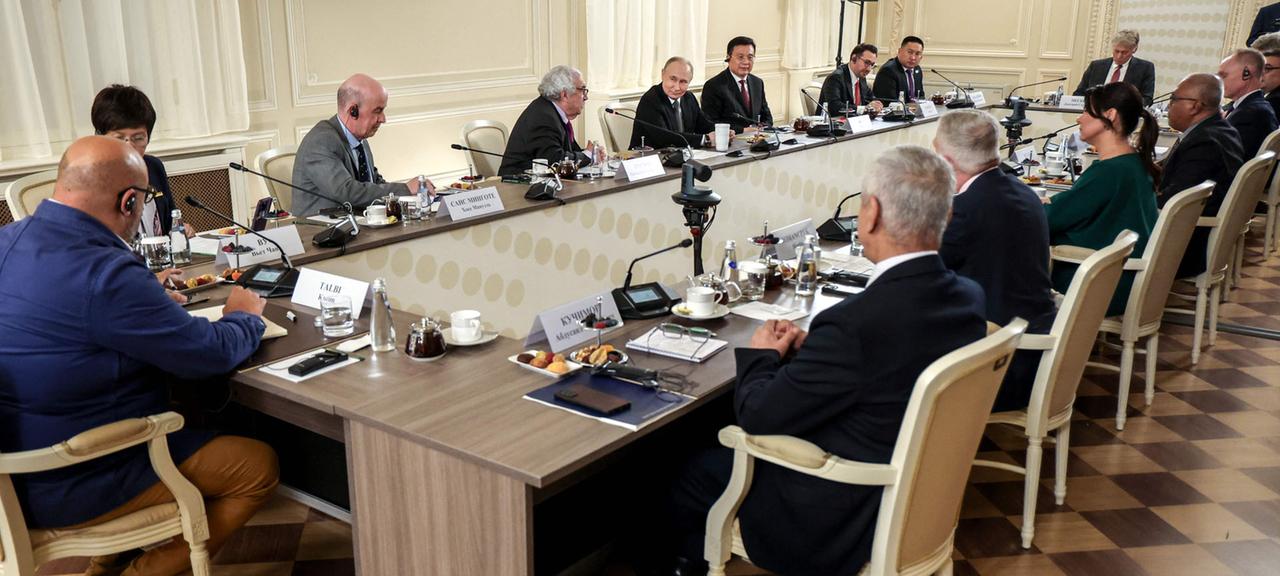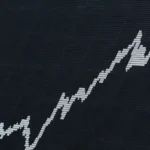Russia’s economic landscape, which recently displayed growth largely propelled by the extensive rearmament efforts since the onset of the war against Ukraine, is now facing a stark warning from within its own leadership.
In an unexpected and remarkably candid statement, Russian Economy Minister Maxim Reshetnikov has issued a cautionary note regarding the looming threat of a recession. Speaking at the prestigious Petersburg International Economic Forum (SPIEF), Reshetnikov not only highlighted the precarious state of the national economy but also publicly criticized the policies of the Central Bank, signaling a growing internal division on economic strategy.
Reshetnikov’s remarks at SPIEF were particularly striking. He observed that “by the numbers, we have a cooling, by the current feelings of entrepreneurs, we are already on the verge of transitioning into a recession.” This nuanced assessment suggests that while official statistics might indicate a slowdown, the on-the-ground sentiment among businesses points to a more immediate and severe downturn.
Beyond this general warning, the Economy Minister specifically raised concerns about a potential collapse in investment, directly attributing this risk to the Central Bank’s prevailing monetary policy. This article will delve into the details of these warnings, the Central Bank’s stance, the underlying factors contributing to Russia’s economic state, and the potential implications of these internal disagreements.
The Looming Recession: Minister’s Warning and Conditions
Economy Minister Maxim Reshetnikov’s statements at SPIEF painted a clear picture of potential economic contraction.
Acknowledging the “Cooling” Economy
Maxim Reshetnikov’s assessment of Russia’s economic situation was notably frank. He observed that “by the numbers, we have a cooling.” This indicates that official economic indicators, such as GDP growth rates or industrial production figures, are already showing a decelerating trend. However, Reshetnikov emphasized that the current situation is more critical when considering the “current feelings of entrepreneurs.”
According to the business community, he stated, Russia’s economy is “already on the verge of transitioning into a recession.” This distinction between official statistics and practical business sentiment highlights a significant disconnect, suggesting that the real-world impact of economic policies might be more severe than initial data suggests. Entrepreneurs, facing high borrowing costs and uncertain market conditions, are signaling a palpable sense of apprehension regarding future investments and growth.
Recession is “Avoidable” Yet Contingent on Policy
Despite his stark warning, Reshetnikov was quick to assert that a recession is not an inevitable outcome. He firmly stated that such an economic downturn “is avoidable.” However, he immediately qualified this by emphasizing that preventing a recession is entirely dependent on “political decisions,” with a particular focus on “interest rates.” He clarified his earlier remarks, stating, “I have no recession predicted. I said, we are on the verge. From now on, everything will depend on our decisions.”
This framing places the responsibility squarely on policymakers, particularly the Central Bank, to adjust their strategies. Reshetnikov’s insistence on adhering to an inflation target of 4 percent further highlights the tension between controlling inflation and stimulating economic growth. He believes that achieving this inflation target while simultaneously fostering investment is crucial to navigating away from a recessionary path. This stance implies that current high interest rates, while intended to curb inflation, are simultaneously stifling the very investments needed for growth.
Central Bank Policies Under Fire: The Interest Rate Debate
The Economy Minister directly pointed fingers at the Central Bank’s high interest rate policy as a deterrent to investment.
Demotivating Entrepreneurs with High Rates
Reshetnikov’s criticism of the Central Bank’s policies was direct and unambiguous. He specifically stated that the “current interest rate level demotivates entrepreneurs to invest.” This points to a fundamental disagreement over monetary policy within Russia’s economic leadership. High interest rates significantly increase the cost of borrowing for businesses, making it more expensive to secure loans for expansion, new projects, or even maintaining existing operations.
When the cost of capital is prohibitive, companies naturally scale back their investment plans, which then dampens overall economic activity and long-term growth prospects.
Adding to the frustration, the Central Bank had only recently made a marginal adjustment to its key interest rate, reducing it “unwesentlich from 21 to 20 percent.” This minor cut was perceived by the Ministry of Economy as insufficient to stimulate the necessary investment. Consequently, Reshetnikov estimated that “in the third and fourth quarters, investments could be below last year’s level.” This projection is a worrying sign for the Russian economy, as declining investment directly translates to reduced future productive capacity and slower economic development.
Kremlin’s Concerns and Record Borrowing Costs
The Kremlin itself has also weighed in on the interest rate debate, indicating a consensus with the Economy Ministry on this issue. Official statements from the Kremlin have recently acknowledged that the “current key interest rate is hindering the economy.” This shared concern underscores the severity of the problem. Businesses in Russia are currently facing “record-high borrowing costs.” Such exorbitant costs make it “hardly possible for entrepreneurs to make investments,” effectively freezing capital expenditure and innovation.
This situation is particularly detrimental to the “long-term development of the economy,” as it stifles the very engines of future growth – new projects, technological advancements, and expansion of production capacities. The high interest rate environment, while designed to combat inflation, is evidently creating significant headwinds for the real economy, leading to a perilous balancing act for Russia’s financial authorities.
Central Bank’s Defense and the Exhaustion of Resources
Central Bank Governor Elvira Nabiullina defended her institution’s monetary policy but also conceded the need for a new economic model.
Defending Monetary Policy Amidst Difficulties
Central Bank Governor Elvira Nabiullina forcefully defended her institution against accusations of implementing an incorrect monetary policy. Despite the criticisms, she also “predicted difficulties” for Russia’s economy, signaling her awareness of the challenges ahead. Nabiullina highlighted that “Russia’s economy had grown for two years despite the sanctions” imposed by the allies of Ukraine. This growth, she explained, was primarily fueled by “programs for import substitution” and robust financial support derived from “funds from the welfare fund and existing capital reserves of the banking system.”
Her defense emphasizes the Central Bank’s role in maintaining financial stability and liquidity, which allowed the economy to weather the initial shock of Western sanctions and adapt to new realities. This growth was thus largely a function of strategic government spending and the utilization of existing financial buffers, rather than organic, private sector-led investment.
The Depletion of Key Resources
However, Nabiullina also delivered a stark and significant admission: “We must understand that many of these resources are actually depleted.” This candid statement reveals a critical turning point for the Russian economy. The “welfare fund” (National Wealth Fund), which serves as Russia’s sovereign wealth fund, and the banking system’s capital reserves were crucial in cushioning the impact of sanctions and funding import substitution efforts.
Their depletion means that Russia can no longer rely on these financial buffers to stimulate growth. This necessitates a fundamental shift in economic strategy. Nabiullina underscored this by stating, “and we must think about a new growth model.” This call for a new model suggests that the previous strategy, reliant on military spending and drawing down reserves, is no longer sustainable. It implies a need for deeper structural reforms and alternative drivers of economic activity, a challenge made more complex by ongoing international isolation and sanctions.
Growth Drivers and Current Economic Stagnation
The recent economic growth in Russia has been tied almost exclusively to military expenditures, masking underlying weakness in civilian sectors.
Growth Fueled by Massive Rearmament
For the past three years, Russia has been engaged in its “attack war against Ukraine.” The economic growth observed during this period has been overwhelmingly based on a “massive rearmament” program. This refers to a significant increase in military production, defense spending, and related industrial activities. Government expenditure on the military and security sectors has surged, diverting vast financial and human resources towards these areas.
While this boosted industrial output in certain segments and created jobs in defense factories, it did so at the expense of other, more civilian-oriented sectors. This type of growth, often termed “war economy” growth, is inherently unsustainable in the long term and does not reflect a healthy, diversified economic structure. It effectively masks underlying weaknesses in other areas of the economy.
Civilian Sectors in Recession and Stagnation
A stark and concerning assessment comes from the “Centre for Macroeconomic Analysis and Short-term Forecasting,” a think tank closely affiliated with the Russian government. This week, the think tank issued a report stating that “most civilian sectors were in a recession.” This is a critical distinction, illustrating that while military production might be booming, the vast majority of industries that cater to consumer needs, services, and non-defense manufacturing are experiencing contraction.
Furthermore, the analysts expressed deep pessimism about the future, noting that “there were no signs of how economic growth could be stimulated again” in these civilian areas. Their grim conclusion: “It seems as if the economy is stagnating.” This assessment from a pro-government entity is highly significant, indicating that the economic challenges extend far beyond ministerial disputes over interest rates and point to a deeper structural problem within the Russian economy, where military spending is effectively propping up an otherwise struggling civilian sector.
This kind of stagnation can lead to a decline in living standards, reduced innovation, and a lack of diversified economic opportunities.
The Impact of Sanctions: Hitting Key Industries
International sanctions, imposed by Ukraine’s allies, are now taking a significant toll on Russia’s vital raw material industries, notably the energy sector.
Sanctions’ Broad Economic Pressure
The comprehensive sanctions imposed by Ukraine’s allies have been designed to exert immense pressure on the Russian economy. These measures target various sectors, aiming to restrict Russia’s access to international finance, technology, and key markets. The impact of these sanctions is now becoming increasingly apparent, particularly in the raw material industry, which forms the backbone of Russia’s export economy.
The long-term effects of these restrictions, including limitations on equipment imports, technology transfer, and access to Western expertise, are gradually undermining the operational capabilities and profitability of these vital industries. The cumulative effect of these sanctions is creating significant structural challenges, forcing Russia to seek alternative markets and partners, often at a reduced profit margin.
Gazprom’s Historic Losses
One of the most dramatic indicators of the sanctions’ effectiveness is the financial performance of Gazprom. For a quarter-century, Gazprom, Russia’s state-controlled energy giant, stood as the “most important source of money for the Russian budget.” Its consistent profitability fueled government spending and provided a stable foundation for the national economy.
However, in 2024, Gazprom suffered a billion-dollar loss. This loss marks a monumental turning point, as it is the first time the company has reported a net loss after twenty-five consecutive years of profits. This historic reversal underscores the profound impact of the geopolitical shift and sanctions on Russia’s primary revenue generator.
The situation is projected to worsen, with the concern that the “company is threatening to slide even deeper into the red in 2025.” This anticipated further decline is largely attributable to two critical factors. Firstly, the “loss of the European market” has been devastating. Europe, once Gazprom’s largest and most lucrative market, has significantly reduced its reliance on Russian gas in response to the war in Ukraine. This strategic decoupling has left a massive void in Gazprom’s export portfolio, which cannot be fully compensated by redirection to other markets, particularly China, due to infrastructure limitations and pricing dynamics.
Secondly, “falling gas prices” globally have compounded Gazprom’s woes. The combination of reduced demand from key markets and a general decline in commodity prices creates a double blow to the company’s revenue streams, directly impacting its profitability and, consequently, the Russian state budget.
Precarious Economic Future
The candid warnings from Russia’s Economy Minister, Maxim Reshetnikov, coupled with the Central Bank’s acknowledgment of depleted resources and the dire assessments from pro-government think tanks, paint a precarious picture for the Russian economy. While significant rearmament efforts have artificially inflated growth figures in recent years, this has masked a deep-seated recession in the civilian sectors and an unsustainable reliance on depleting financial reserves.
The ongoing friction between the Ministry of Economy and the Central Bank over high interest rates underscores fundamental disagreements on how to navigate these challenges. The devastating financial losses experienced by Gazprom, a long-standing pillar of the Russian budget, clearly demonstrate the tangible impact of international sanctions and the strategic shift away from Russian energy by key markets. As Russia grapples with these internal and external pressures, the call for a “new growth model” becomes increasingly urgent.
Without significant policy adjustments and a genuine re-evaluation of its economic priorities, Russia faces the very real prospect of a prolonged period of economic stagnation or even a deeper recession, with far-reaching consequences for its domestic stability and global standing.








